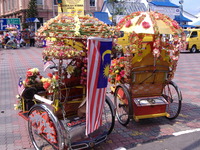Malacca
In the Southern tip of the Malaysian peninsular, lying just across the straits from Singapore, Malacca (also known as Melaka) has an impressive cultural heritage, not surprising given that back in the late 1400s it was a major centre for and originator of Malay culture. Since then the region has had many influences including Islam, the Catholic Portuguese and the Protestant Dutch before being administrated by the British East India Company. Parallel to this changing of colonial hands, Malacca went from being the major trading port of the area to playing second fiddle to Singapore and Penang. Now sleepy and relaxed, Malacca basks in Eastern charm and should be of particular interest to the cultural tourist.
Attractions
Fortunately the colonial buildings in the centre of Malacca have been zealously conserved by the local authorities. These congregate on the Eastern banks of the sungei Malacca â the river that cuts through the town, around the Bukit St Paul, otherwise known as St Paulâs Church. This, the Christ Church, the Dutch Graveyard and the Church of St Francis Xavier are all picturesque reminders of the various European communities whoâve settled or passed through Malacca, whether Calvinist, Jesuit or Brit.
 That done, there remains the Chinatown to be explored, just across the river. Here the atmosphere is very different, with lots of pokey shops and sombre restaurants. Jalan Hang Jebat, âJunk Streetâ, epitomises this, with grand Chinese antique shops lining the street. The area also has a number of places of worship, including an elegant little minaret just off Jalan Hang Jebat and next door to a blue Hindu Temple. Add to this the nearby Tokong Cheng Hoon, Temple of the Merciful Cloud, and the eighteenth century Masjid Kampung Hulu, respectively thought to be the countryâs oldest Chinese temple and oldest mosque.
That done, there remains the Chinatown to be explored, just across the river. Here the atmosphere is very different, with lots of pokey shops and sombre restaurants. Jalan Hang Jebat, âJunk Streetâ, epitomises this, with grand Chinese antique shops lining the street. The area also has a number of places of worship, including an elegant little minaret just off Jalan Hang Jebat and next door to a blue Hindu Temple. Add to this the nearby Tokong Cheng Hoon, Temple of the Merciful Cloud, and the eighteenth century Masjid Kampung Hulu, respectively thought to be the countryâs oldest Chinese temple and oldest mosque.
The streets leading out of Chinatown are full of large town houses built by the Baba-Nonya community, immigrants from China. The Baba-Nonya Heritage Mueseum offers the chance to explore a particuarly gorgeous example of this Chinese Palladian style and is on Jalan Tun Tun Cheng Lock, otherwise known as Millionaires Row. Beyond Chinatown, Bukit China, the Chinese communityâs burial ground, which dates back to the fifteenth century, is also worth a visit, not least to see the beautiful and elaborate Cheng Hoon Teng temple.
Right in the centre, the Malay area of Kampung Morten is curious in that all the houses are wooden and perched high on stilts â distinctly Malakan! For more history in the Malay vein, the Museum of Ethnography is informative and interesting.
Shopping
Malacca is first and foremost a great place to buy Chinese antiques, ranging from ancient and ornate genuines to easier-on-the-wallet trinkets and paraphernalia. Various items relating to Malaccaâs different religions can be found around town, whether it be books, images and statues, and thereâs also a few small, speciality shops, which sell things such as old coins or silk shoes.
Nightlife and Eating Out
Around town there are various hawker food stalls which are popular with the locals and serve up all sorts of local dishes. Though basic, the food at these stalls is inexpensive and generally excellent. Otherwise, the choice is between Nonya, mainland Chinese, Malay, Indian or Portuguese cuisines and thereâs, literally, something for everyone.
Tourist Information
Pejabat Tourism Malaysia Melaka, Tingkat 9, Bangunan Graha Maju, Jalan Graha Maju, Melaka 75300 Tel: +60 (0) 6288 3304 Email: mtpb.melaka@tourism.gov.myOfficial Malaysia tourism websiteUnofficial Malacca tourism website
Airport
Malakaâs small airport, Batu Berendam, is about 10km out of town and is relatively easy to get to. The principal destination of outgoing flights is Pekanbaru in Sumatra.
Popular car hire locations in Malaysia
All car hire locations in Malaysia
- Bintulu Airport

- George Town

- Jelutong

- Johor Bahru

- Kampung Bakau

- Kampung Subang

- Kerteh Airport

- Klang

- Kota Kinabalu

- Kota Kinabalu International Airport

- Kuala Lumpur

- Kuala Lumpur International Airport

- Kuantan Airport

- Kuching International Airport

- Kulim

- Labuan Airport

- Langkawi

- Langkawi International Airport

- Lumut

- Malacca Airport

- Melaka

- Miri Airport

- Penang International Airport

- Perai

- Sandakan Airport

- Senai International Airport

- Sibu Airport

- Sitiawan Airport

- Sultan Abdul Aziz Shah International Airport

- Sultan Abdul Halim Airport

- Sultan Azlan Shah Airport

- Sultan Ismail Petra Airport

- Sultan Mahmud Airport

- Taiping (tekah) Airport




